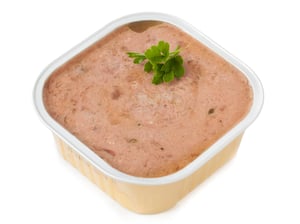 We at ICPG are pet lovers - collectively, our furry friends outnumber us almost 2:1. For us, our pets aren’t just fun companions, they’re part of our family. And judging by the size of the pet food industry, which in 2018 was estimated to be $86.8 billion global industry, we aren’t the only ones. According to Mordor Intelligence Research, the North American pet food industry makes up approximately 37% of the global market, with a projected 4.4% CAGR through 2025, which can be correlated to the high household pet ownership of approximately 80 million dogs and 90 million cats. Similar to many other segments of the US retail economy, much of this growth can be attributed to Millennial and e-commerce related sales.
We at ICPG are pet lovers - collectively, our furry friends outnumber us almost 2:1. For us, our pets aren’t just fun companions, they’re part of our family. And judging by the size of the pet food industry, which in 2018 was estimated to be $86.8 billion global industry, we aren’t the only ones. According to Mordor Intelligence Research, the North American pet food industry makes up approximately 37% of the global market, with a projected 4.4% CAGR through 2025, which can be correlated to the high household pet ownership of approximately 80 million dogs and 90 million cats. Similar to many other segments of the US retail economy, much of this growth can be attributed to Millennial and e-commerce related sales.
In recent years, this market has seen a strong trend in "premiumization," which can be attributed to the increase in pet food quality and specialization of pet foods ranging from unique portion sizes, clear plastic containers and the drive for pet food companies to more closely emulate human food/meals. Other innovations in the pet food segment such as home-delivered meal kits, specialty food with preventative benefits, or micro-target pet foods, are just a few of the trends that are taking off within the industry, offering opportunity for premium pet food packaging that provides differentiation and customization to increase brand awareness.
As with any shelf-stable commercially packaged product that we would put on our plate, ensuring quality and safety throughout the duration of the product’s shelf-life through processing techniques and specialty engineered packaging materials is essential to keeping our furry friends healthy, happy, and satisfied. Continue reading to learn more about some of the key considerations when developing pet food packaging materials for refrigerated and extended shelf-life applications.
What are the barrier requirements?
Determining the material and barrier requirements for rigid plastic pet food containers is essential to developing a high-performance package that meets the critical needs for the application. There are several key considerations in developing the material structure including processing conditions, supply chain, retail conditions, organoleptic properties and shelf life expectation. Current structures used for this market utilize a multi-layer barrier PP/EVOH/PP structure to provide the necessary OTR & MVTR properties. Additionally, with the severe conditions of retort processing, maintaining container integrity throughout the processing cycle and minimizing or eliminating retort “shock” are critical elements to providing a safe, high performance package.
Structure and material design considerations are therefore key to protecting the EVOH layer throughout the retort process to ensure adequate protection is provided for the food product in order to maintain freshness while providing extended shelf life performance. As an additional consideration, container part design plays a significant role in assuring consistent material distribution is achieved during the thermoforming process to maintain a pre-specified minimum thickness in order to retain barrier performance.
What is the processing method?
 Refrigerated and shelf-stable pet food packaged in plastic containers is put through the retort process as a method of sterilization. Beginning with canning of wet pet foods and evolving into rigid plastic containers and flexible pouches, the retort process is a proven technique in this market as a way for pet food processors to ensure the quality of their product while taking advantage of large-scale production. Typically, in retort packaging, the food product is cooked while packed and sealed inside the container and can offer an extended shelf life of up to 16-24 months depending on supply chain and storage conditions. Understanding the processing and sterilization method is key when developing the optimum package for shelf stable pet food containers. Additionally, barrier requirements play a key part in determining the best material structure to maintain the safety and integrity of the food product given the product PH, residual head space and target shelf-life.
Refrigerated and shelf-stable pet food packaged in plastic containers is put through the retort process as a method of sterilization. Beginning with canning of wet pet foods and evolving into rigid plastic containers and flexible pouches, the retort process is a proven technique in this market as a way for pet food processors to ensure the quality of their product while taking advantage of large-scale production. Typically, in retort packaging, the food product is cooked while packed and sealed inside the container and can offer an extended shelf life of up to 16-24 months depending on supply chain and storage conditions. Understanding the processing and sterilization method is key when developing the optimum package for shelf stable pet food containers. Additionally, barrier requirements play a key part in determining the best material structure to maintain the safety and integrity of the food product given the product PH, residual head space and target shelf-life.
Today, thermoformed containers are ideally suited to meet the challenges of retort packaging taking into consideration the product volume, density and required sterilization. As the pet food industry continues to evolve, the need for higher speed processing capabilities that allow companies to keep up with growing demand while simultaneously meeting higher quality requirements are critical. ICPG's XPP™ with enhanced OTR & MVTR performance can support the industry by reducing the impact that the abusive nature the retort cooking process has on the product while improving shelf-life quality.
What is the best material choice?
Determining the base resin and material structure for pet food applications is largely dependent on the type of packaging and processing method being used in conjunction with the target shelf-life requirements. As noted above, the majority of rigid barrier plastic pet food containers supplied to the market today use retort processing as the primary method of processing and sterilization. Polypropylene material structures combined with an EVOH barrier achieved through a multi-layer coextruded structure offer an ideal solution to achieve the required performance to withstand the rigors of retort processing. Due to the exposure of high pressure and temperatures in the retort process, polypropylene tends to be the ideal material of choice to withstand retort temperatures reaching +255°F. Additional considerations focus on post-retort requirements given the environmental conditions experienced throughout the distribution chain, retail shelf and ultimately to the consumer.
Innovative new polypropylene products, such as ICPG's XPP™ Enhanced Barrier Polypropylene can provide up to 80% improvement in MVTR barrier properties over traditional polypropylene materials, offering enhanced protection of the EVOH layer to protect the packaging against retort shock, thus keeping the product safe and fresh.
Interested in learning more about XPP™ Enhanced Barrier Polypropylene for your premium pet food packaging applications? Download our Pet Food Solutions sheet today:





